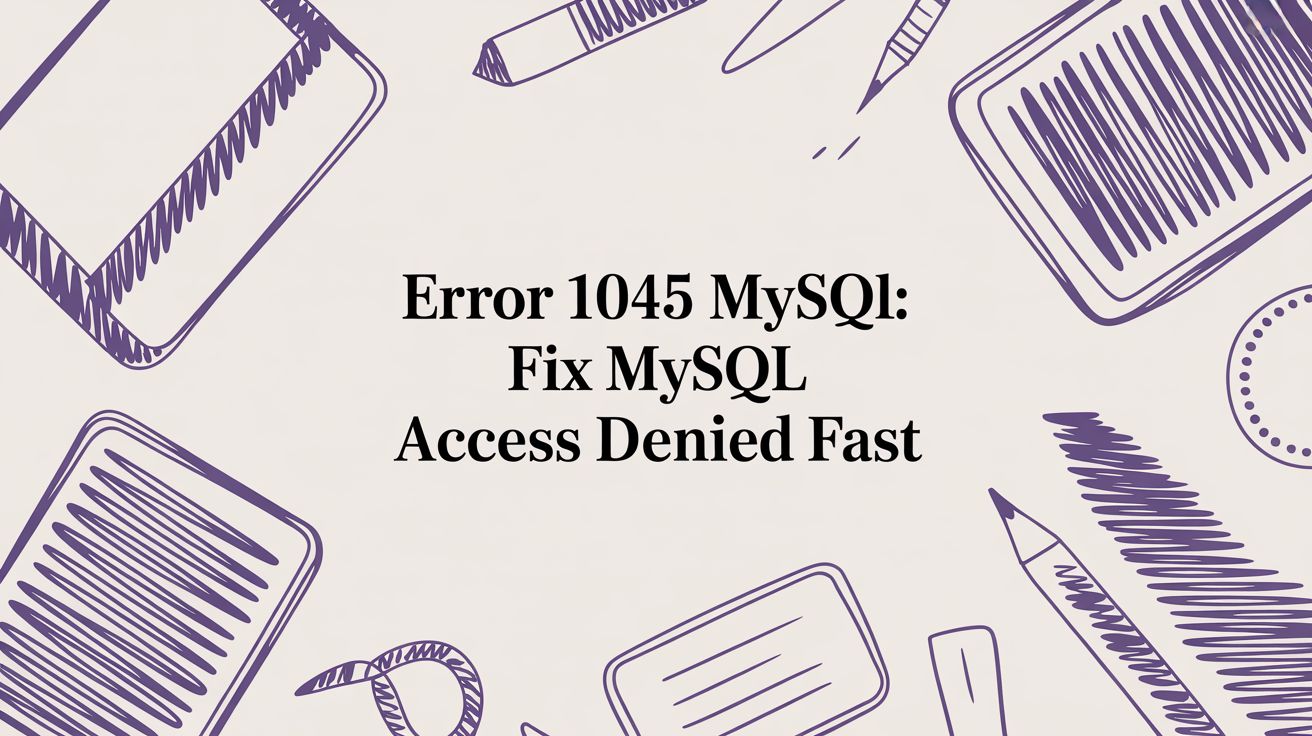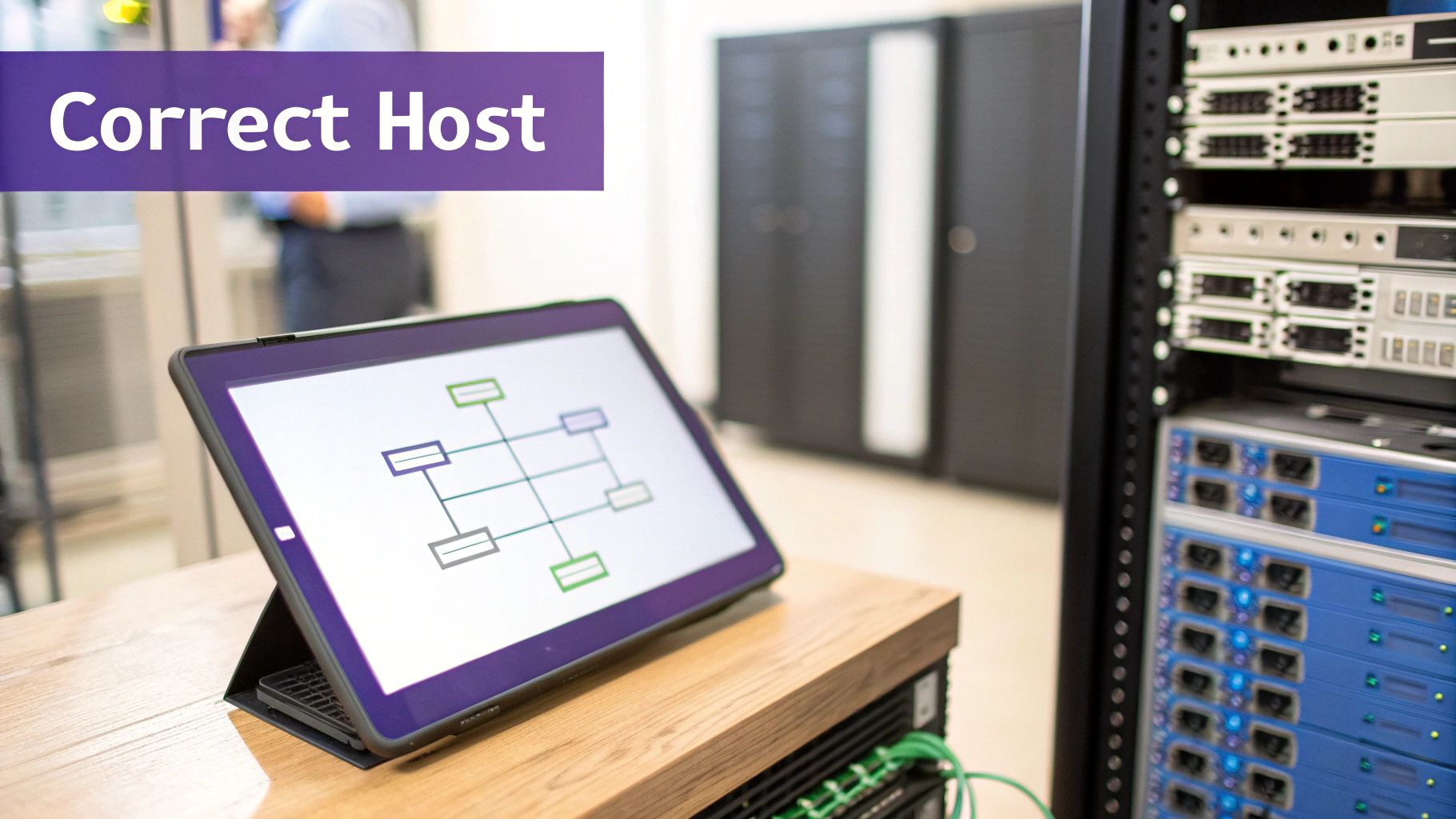How to Fix MySQL Error 1045: Access Denied (A Step-by-Step Guide)

Nothing stops a developer or system administrator in their tracks quite like the infamous MySQL error 1045. This message, officially known as ER_ACCESS_DENIED_ERROR, is a hard stop. It means the database server has flat-out rejected your login attempt, and it’s almost always due to incorrect credentials, insufficient permissions, or connecting from an unauthorized location. This guide will walk you through diagnosing the root cause and implementing the correct fix, turning a frustrating roadblock into a solvable problem.
Are you tired of unexpected database errors disrupting your workflow? Server Scheduler helps you automate routine maintenance and operations, preventing issues before they start. Schedule server restarts, apply updates, and manage resources effortlessly to maintain a stable and secure database environment.
Contents
- Understanding What Error 1045 Really Means
- Fixing Common Credential and Privilege Issues
- Solving Host and Network Configuration Errors
- Handling Authentication Plugin Mismatches
- Dealing With Access Issues in Managed Databases like RDS
- Securing Your Database After the Fix
- Frequently Asked Questions About Error 1045
Ready to Slash Your AWS Costs?
Stop paying for idle resources. Server Scheduler automatically turns off your non-production servers when you're not using them.
Understanding What Error 1045 Really Means
When you encounter Error 1045: Access denied for user, it's crucial to understand that this isn't a server crash or a bug. It is a security feature functioning exactly as intended. The MySQL server is designed to verify three key pieces of information for every connection attempt: the username, the password, and the hostname from which the connection originates. It meticulously compares this combination against its internal grant tables. If an exact match isn't found, the connection is refused. This error is one of the most common hurdles for developers and administrators, always associated with the SQLSTATE code 28000, which specifically signals an authentication failure. For a deeper technical dive, you can find more details about MySQL authentication errors on chat2db.ai.
The error message itself provides all the necessary clues for troubleshooting. A typical message looks like this: ERROR 1045 (28000): Access denied for user 'someuser'@'localhost' (using password: YES).
Breaking down this output is the key to resolving the issue efficiently. The 'someuser' part indicates the username attempted, 'localhost' specifies the connection source, and (using password: YES/NO) reveals whether a password was provided. YES means a password was sent but was incorrect, while NO means no password was provided, yet the account requires one. This detailed feedback allows you to pinpoint precisely where the authentication process failed, distinguishing between a local access issue ('user'@'localhost') and a remote one ('user'@'192.168.1.100').
Fixing Common Credential and Privilege Issues
When the error 1045 mysql message appears, it’s usually the database's security protocols doing their job. While frustrating, it signifies a mismatch between the credentials provided and the user's actual permissions. Most solutions involve addressing one of two primary causes: an incorrect password or a user lacking the necessary privileges for the requested action. The most severe scenario is losing root access, which feels like being locked out of your own system.
A powerful, albeit drastic, solution for regaining root access is to restart the MySQL server with the --skip-grant-tables option. This command effectively tells the server to bypass all standard security checks, granting open access. This method should only be used as a last resort because it leaves your database entirely vulnerable. The process involves stopping the MySQL service (sudo systemctl stop mysql), restarting it with the special flag (sudo mysqld_safe --skip-grant-tables &), and then logging in as the root user without a password to reset the credentials.
Once access is restored, it's crucial to properly configure user privileges to prevent future lockouts. Many Error 1045 instances stem from simple security misconfigurations. Proactively learning to remediate security misconfigurations can save significant time and effort. The GRANT command is essential here, but it's important to understand the host specification. Granting privileges to 'myuser'@'localhost' is entirely different from 'myuser'@'%'. The former restricts connections to the local machine, while the latter allows connections from any host, which is less secure. A specific grant might look like: GRANT ALL PRIVILEGES ON mydatabase.* TO 'myuser'@'localhost' IDENTIFIED BY 'a_strong_password';.
Finally, any changes to user grants or passwords, especially after using --skip-grant-tables, must be followed by the FLUSH PRIVILEGES; command. This non-negotiable step forces the server to reload the grant tables from disk, applying your changes immediately without requiring a full server restart. After securing the privileges, you should restart the MySQL server normally to re-enable its security features.
Solving Host and Network Configuration Errors
Sometimes, even with the correct username and password, you can still be confronted with Error 1045. This situation often points to a host or network configuration problem. MySQL's security model is granular, authenticating not just a user, but a user connecting from a specific host. An account like 'app_user'@'localhost' is treated as a separate entity from 'app_user'@'192.168.1.10'. This distinction is a classic pitfall where an application on one server fails to connect to a database on another because the user account was only configured for local access.
The error message provides the best clue. If it states Access denied for user 'app_user'@'10.0.5.20', it confirms that MySQL received a connection attempt from that specific IP. Your next step is to check your grant tables to see if that user is permitted to connect from that host. To fix this, you must grant privileges to the user from the correct originating host. After identifying the application's IP address from its connection string or environment variables, you can run a command like GRANT ALL PRIVILEGES ON your_database.* TO 'app_user'@'192.168.1.10' IDENTIFIED BY 'password';, followed by FLUSH PRIVILEGES;.
Another common network-related culprit is the bind-address setting in the MySQL configuration file (my.cnf or mysqld.cnf). This directive controls which network interface MySQL listens on.

If bind-address is set to 127.0.0.1 (a common default), MySQL will only accept connections from the server itself (localhost), blocking all remote attempts regardless of user grants. To resolve this, you must edit the file, changing the bind-address to 0.0.0.0 to listen on all interfaces or to the server's specific private IP. This change requires a restart of the MySQL service to take effect. For administrators who frequently search through configuration files, our guide on how to grep for multiple patterns can be a significant time-saver.
Handling Authentication Plugin Mismatches
It can be maddening when you've verified the username, password, and host, yet you still face the dreaded error 1045 mysql. If you are connecting an older client or application to a modern MySQL server (version 8.0 or newer), the issue might be a subtle authentication plugin mismatch. This problem is particularly tricky because it masquerades as a simple password failure, sending you down the wrong troubleshooting path.
Newer MySQL versions default to a more secure authentication method called caching_sha2_password. However, many legacy applications and drivers were built for the older mysql_native_password plugin. When an old client attempts to connect, the server and client cannot agree on how to handle the password hash, resulting in a connection refusal. To diagnose this, you must log in with an administrative account and check the plugin used by the problematic user account by querying the mysql.user table: SELECT user, host, plugin FROM mysql.user WHERE user = 'your_username';.
If the result shows caching_sha2_password and you know your client is incompatible, you have found the root cause. The fix involves altering the user account to use the more compatible mysql_native_password plugin. This is done with the ALTER USER command, ensuring you re-specify the password to re-hash it with the new method: ALTER USER 'app_user'@'localhost' IDENTIFIED WITH mysql_native_password BY 'their_strong_password';. Remember to run FLUSH PRIVILEGES; afterward to apply the change immediately.
| Feature | caching_sha2_password |
mysql_native_password |
|---|---|---|
| Default In | MySQL 8.0+ | MySQL 5.7 and earlier |
| Security | Stronger (SHA-256 hashing) | Weaker (SHA-1 hashing) |
| Compatibility | Requires modern clients/drivers | Universally supported |
| Performance | Faster due to server-side caching | Slower; re-authentication required |
Dealing With Access Issues in Managed Databases like RDS
When working with managed database services like Amazon RDS or Google Cloud SQL, the traditional troubleshooting methods for error 1045 mysql do not apply. You cannot simply SSH into the server and use --skip-grant-tables. These platforms abstract direct server access, requiring you to use their provided tools and interfaces to manage security and configuration.
If you lose access to the master user account for your RDS instance, the password reset process is handled through the cloud provider's console or CLI. For example, in AWS, you would navigate to the RDS dashboard, select your database instance, and use the "Modify" option to set a new master password securely. This action is managed by the platform and may trigger a brief instance reboot, but it is the standard cloud-native procedure for regaining access.
However, an access denied error in a managed environment is not always about credentials. A frequent cause is a network configuration issue, such as a misconfigured VPC security group. Security groups act as virtual firewalls for your database instance. If the security group does not have an inbound rule allowing traffic from your application's IP address on port 3306, the connection will be dropped before authentication is even attempted. This can result in a timeout or connection error that mimics a credential failure. Therefore, if a password reset doesn't work, your next step should be a thorough review of the entire network path, including security group rules and VPC network ACLs, to ensure a clear path exists between your application and the database.
Securing Your Database After the Fix
Successfully resolving MySQL error 1045 is a significant relief, but the work isn't over. Regaining access is the first step; the next is to fortify your database to prevent future issues. This moment provides a perfect opportunity to review and enhance your security practices. A foundational security measure is to adhere to the principle of least privilege. Avoid using the root user for application connections, as this creates a substantial security risk. Instead, create a dedicated user for each application with only the permissions it absolutely needs to function.
Regular security audits are also essential for maintaining a secure database. Make it a routine to review all user accounts and their grants with SHOW GRANTS FOR 'user'@'host';. Look for excessive permissions, such as ALL PRIVILEGES, and revoke them if they are not necessary. Additionally, enforce a password rotation policy and remove any dormant accounts that are no longer in use. These simple checks can dramatically reduce your database's attack surface. Complementing these practices with a robust backup strategy, as detailed in our guide on backing up Linux systems, will ensure your data remains safe.
 Frequently Asked Questions About Error 1045
Frequently Asked Questions About Error 1045
The error 1045 mysql is a common issue, and many developers have faced it. Here are answers to some of the most frequently asked questions to help you resolve it quickly.
Can I Fix Error 1045 Without a Server Restart?
Yes, in most cases. A server restart with --skip-grant-tables is a last resort for when you are completely locked out of all administrative accounts. If you have access to another user account with GRANT privileges, you can simply log in with that account and reset the password or adjust the permissions for the user that is locked out. This is the preferred method as it avoids database downtime and temporary security risks.
Why Do I Get Access Denied for Root at Localhost?
This is the most classic error 1045 mysql scenario. The most common reason is a simple password typo. Another frequent cause is attempting to connect as root without supplying a password when one is required, which often happens after a fresh MySQL installation that enforces stricter default security. The (using password: YES/NO) part of the error message is a vital clue: YES indicates a wrong password was sent, while NO means no password was provided at all.
Does Using the '%' Wildcard Create a Security Risk?
Yes, it does. Using the '%' wildcard in a user grant, such as 'myuser'@'%', allows that user to connect from any IP address. While convenient for development, it poses a significant security risk in a production environment by exposing your database to the entire network. Best practice is to be as specific as possible, locking down access to the exact IP address or hostname of your application server. This aligns with the principle of least privilege and significantly reduces your database's attack surface.